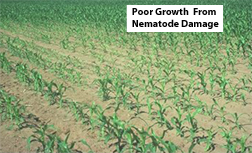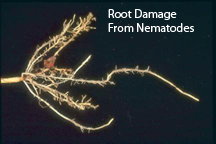| Nematode damage can occur throughout the growing season. Above-ground
symptoms of nematode damage include stunting, thin stands, premature wilting
under moderate heat or drought stress, and nutrient deficiency symptoms.
Since nematode numbers can vary greatly within very short distances in the
field, areas affected by nematodes vary greatly in shape, size, and distribution.
Symptoms are worse in soils that are sandy, dry, and infertile. Roots injured
by nematodes are usually stunted, often with few fine secondary feeder roots.
Root tips may be blunt and swollen. By damaging root tips as soon as they
emerge, nematodes can be especially injurious to young seedlings. Even under
moderate stress, nematode-damaged roots may cause young plants to die, resulting
in a thin crop stands. |


